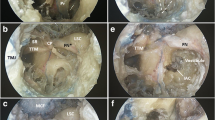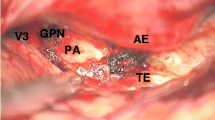Abstract
Background
Petroclival meningiomas are one of the most challenging tumors to be operated in the realm of neurosurgery. Many approaches have been developed over the years.
Method
The authors describe the Half & Half (H&H) approach whose main indication is petroclival meningiomas with suprasellar extension. The part of the tumor located above CN III and in the retrochiasmatic space is addressed through a trans-sylvian, while the petroclival portion is through an extradural anterior petrosectomy approach. The wide surgical corridor given by this approach allows extensive tumor resection while avoiding the risk associated with the manipulation of intracavernous neurovascular structures.
Conclusion
The H&H approach is an effective strategy to maximize the safe resection of petroclival meningiomas.




Similar content being viewed by others
Data availability
Not applicable.
Code availability
Not applicable.
Abbreviations
- CN:
-
Cranial nerve
- CSF:
-
Cerebro-spinal fluid
- GSPN:
-
Greater superficial petrosal nerve
- H&H:
-
Half & half
- IAC:
-
Internal auditory canal
- IPS:
-
Inferior petrosal sinus
- MC:
-
Meckel’s cave
- OTPF:
-
Orbito-temporal periosteal fold
- SOF:
-
Superior orbital fissure
- SPS:
-
Superior petrosal sinus
References
Day JD, Fukushima T, Giannotta SL (1994) Microanatomical study of the extradural middle fossa approach to the petroclival and posterior cavernous sinus region: description of the rhomboid construct. Neurosurgery 34:1009–1016
Fournier HD, Mercier P, Roche PH (2007) Surgical anatomy of the petrous apex and petroclival region. Adv Tech Stand Neurosurg 32:91–146
Froelich SC, Aziz KM, Levine NB, Theodosopoulos PV, van Loveren HR, Keller JT (2007) Refinement of the extradural anterior clinoidectomy: surgical anatomy of the orbitotemporal periosteal fold. Neurosurgery 61(5 suppl 2):179–185
Kawase T, Shiobara R, Toya S (1991) Anterior transpetrosal transtentorial approach for sphenopetroclival meningiomas: surgical method and results in 10 patients. Neurosurgery 28:869–876
Muto J, Prevedello DM, Ditzel Filho LF et al (2016) Comparative analysis of the anterior transpetrosal approach with the endoscopic endonasal approach to the petroclival region. J Neurosurg 125(5):1171–1186
Shibao S, Toda M, Orii M, Fujiwara H, Yoshida K (2016) Various patterns of the middle cerebral vein and preservation of venous drainage during the anterior transpetrosal approach. J Neurosurg 124(2):432–439
Troude L, Carissimi M, Lavieille JP, Roche PH (2016) How I do it: the combined petrosectomy. Acta Neurochir (Wien) 158(4):711–715
Troude L, Bernard F, Baucher G, De La Rosa MS, Roche PH (2017) Extradural resection of the anterior clinoid process: how I do it. Neurochirurgie 63(4):336–340
Troude L, Baucher G, Roche PH (2022) Expanded middle fossa approach: the extradural anterior petrosectomy. In: Youssef AS (ed) Contemporary skull base surgery: a comprehensive guide to functional preservatiOn. Springer Nature, Switzerland AG, pp 453–464
Author information
Authors and Affiliations
Contributions
All authors have made substantial contributions so as to qualify for authorship and have read and approved the final version of this manuscript. LT, TAS, and PHR: conception and design of the study. LT, TAS, and GB: acquisition of data and drafting the article. PHR: critically revised the article.
Corresponding author
Ethics declarations
Ethics approval
Not applicable.
Consent to participate
Informed consent was obtained from the illustrative case patient.
Consent for publication
The patient agreed for publication.
Conflict of interest
The authors declare no competing interests.
Additional information
This manuscript has not been previously published in whole or in part or submitted elsewhere for review.
Key points summary
- H&H approach provides a wide surgical corridor maximizing safe resection.
- Case selection: petroclival meningiomas with suprasellar extension.
- Preoperative workup including CT bone windows (petrous bone anatomy).
- Discuss the necessity to perform an extradural resection of the ACP.
- Avoid manipulation of the intracavernous portion of the tumor.
- Predict the course of CN IV and V before the dura opening.
- Optimize dura opening.
- Risk of postoperative temporal edema.
- Planned non-total tumor resection.
- Adjunctive radiosurgery on tumor residues.
Publisher's Note
Springer Nature remains neutral with regard to jurisdictional claims in published maps and institutional affiliations.
Supplementary Information
Below is the link to the electronic supplementary material.
Supplementary file1 (MP4 484031 KB)
Rights and permissions
Springer Nature or its licensor (e.g. a society or other partner) holds exclusive rights to this article under a publishing agreement with the author(s) or other rightsholder(s); author self-archiving of the accepted manuscript version of this article is solely governed by the terms of such publishing agreement and applicable law.
About this article
Cite this article
Troude, L., Al-Shabibi, T., Baucher, G. et al. The trans-sylvian trans-petrosal “half & half” approach—a how I do it. Acta Neurochir 166, 158 (2024). https://doi.org/10.1007/s00701-024-06056-4
Received:
Accepted:
Published:
DOI: https://doi.org/10.1007/s00701-024-06056-4




